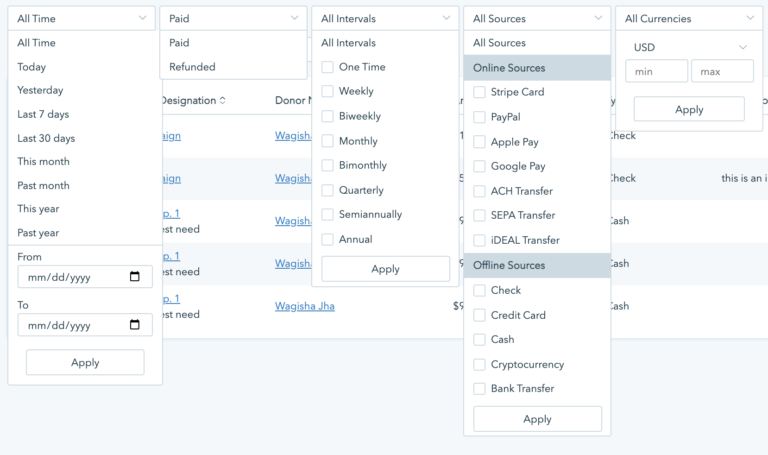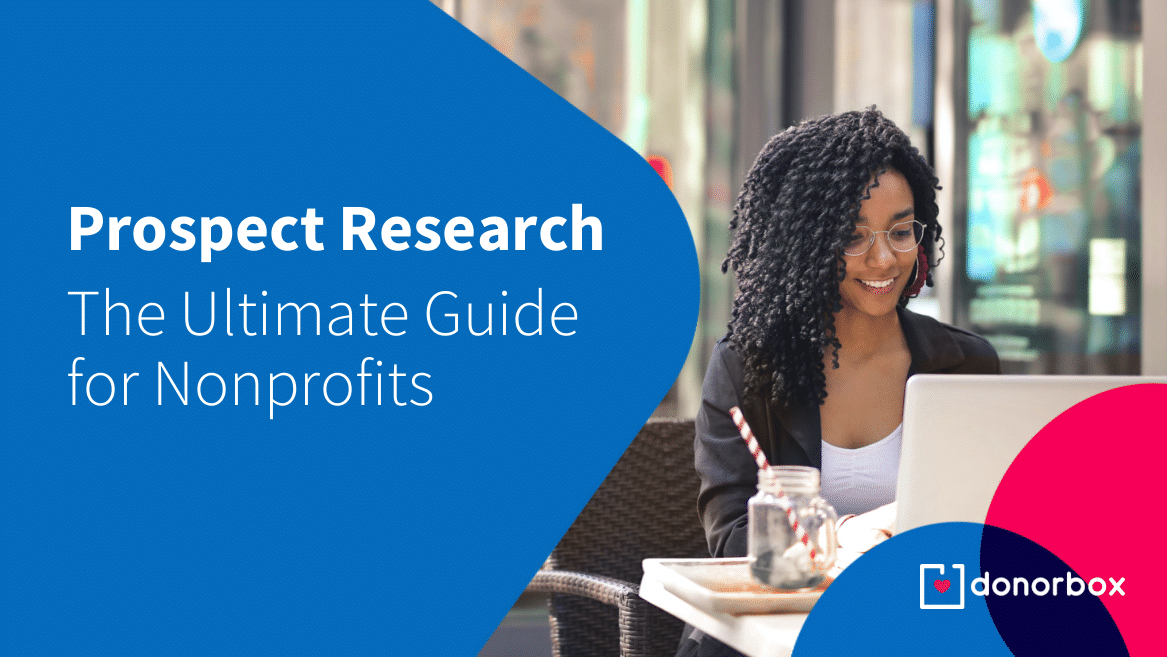Prospect Research is another term for donor research. For growing nonprofits, it might seem like a difficult task requiring a lot of expertise and effort but as you include the right tools and actions in your process, it all gets easier with time. Definitely worthwhile for continuous growth. Your nonprofit will want to perform prospect research for major gift donor outreach, finding new donors, increasing fundraising potential, capital campaigns, planned giving, and other long-term fundraising appeals.
The information your organization finds must be added to your donor management database and updated to help retain important relationships with your donors.
This article breaks down what prospect research involves and how your nonprofit can use prospect research to increase donations.
What is Prospect Research?

Prospect research is simply collecting information about current and potential donors. The aim is to determine whether they can make a donation to your nonprofit, how much they can, and if at all they have the inclination to do so.
Educational institutions including K-12, healthcare organizations, environmental groups, faith-based organizations, arts and cultural organizations, and Greek organizations are all known for using prospect research for their fundraising efforts. But other nonprofits can equally and significantly benefit from prospect research.
When nonprofits perform prospect research, they collect contact details, giving ability, and personal details about the prospects. The most common information your nonprofit will collect includes:
- Personal background
- Philanthropic activity (if board members/ volunteers/ trustees to other nonprofits)
- Wealth insights
- Charity interests
- Donations to other nonprofits (preferably, similar ones)
- Any previous donations to your organization
How Different is Prospect Research from Wealth Screening?

Some may wonder what the difference is between wealth screening and prospect research. Wealth screening is only one part of prospect research. When your nonprofit performs a wealth screening, your prospect researcher team will look at a donor’s real estate ownership, stock ownership, political giving, and other financial details. The purpose of wealth screening is to determine the donor’s ability to give. Prospect research will address why a donor wants to give and what interests they may have in your organization’s mission, including insights into their giving ability.
Why Should You Perform Prospect Research?

Prospect research allows nonprofits to find the best options for fundraising prospects to help raise needed funds. Let’s have a look at why prospect research is essential for your nonprofit.
1. Major donor prospects
Prospect research can help you find potential major donors. With the help of wealth screening tools, you’ll gain some insight into how much these interested donors might be able to give. That way, you can personalize your appeal to them by making a bigger ask. Also, if you turn this research inwards, you might actually end up finding many potential major gift donors right within your current donor database.
2. Planned giving prospects
Planned Giving prospects are also potential major donors. However, you may not receive a gift right away. It’s a long-term process. These donors plan for these major gifts through their overall financial or real estate planning. It may be their life insurance, retirement plan, real estate, gifts of equity, bequests, etc. By performing prospect research to find planned giving donors, you may be surprised by the financial ability some of your donors can provide.
3. Sponsorships

Nonprofits can gain sponsorship from local and national businesses. By performing prospect research on these companies, your team of prospect researchers can find necessary details like the company’s revenue and ability to give, their past/present philanthropic behavior in the market, along with the name and information for the right individual to contact.
4. Alumni giving
Alumni are another donor base that may provide significant funding if an organization’s communication plans are targeted to the individuals. Nonprofits must perform prospect research to find which young adults/university students or graduates have enough personal wealth to donate. You may also want to find specific programs to interest the donor. Such data will especially be useful in the case of university fundraising efforts.
An example of this can be scholarships for students in programs the donor used.
5. Capital campaign donors
Nonprofits may start capital campaigns to fund large projects like a new building or purchase. But to make them successful, you need to find donors within the community who will give in bigger amounts. The first step to creating these campaigns should be prospect research to ensure you reach out to the right people for making the ask.
6. Giving data of your existing donors
Prospect research is not just for donors who are yet to be discovered and convinced to give. You should often run this activity within your own donor management system to find out and analyze the giving patterns of your existing donors.
This will help you change your approach to donors from time to time to get more donations. Also, as you start a new fundraising campaign, the fundraising professionals you hire will know which donors to reach out to based on your needs/goals. This data will also help improve your fundraising scripts for different donor types.
An effective donor management system should give you insights into donors’ giving patterns. It should help you segment donor records based on filters like donation amount, giving frequency, payment sources, and more (as shown in the below image). That’s the basic need for every nonprofit that wants to build and strengthen relationships with its donors. Donorbox lets you manage and track your donors and donation records, segment donors, add communication notes, and keep track of important donor moments. A system like this will help you manage the researched data more effectively.

8 Mandatory Data Points to Include in Prospect Research

When performing prospect research, you must collect as much information on potential donors as possible. The primary areas of interest will be their wealth, their giving abilities, and their affinity for causes similar to yours, so you’ll need to find more information about:
1. Salary and employment
If you can find information on a donor’s salary, you have a better idea of their ability to give. For many major gift donors, their salary estimates are only one part of a larger picture. A few more insights you want to have are:
- Do they own a business?
- How many employees does that business have?
- What is the revenue of that business?
- Do they have other sources of income?
Business owners will likely have more significant wealth and a greater giving ability than other donors. These prospects are also an excellent sponsorship opportunity.
You will also want to research donors’ companies to see if they have a matching gift program. If their employer does offer this opportunity, their donations can be doubled or tripled.
2. Real estate ownership
Real estate ownership remains a meaningful sign of wealth. You should definitely conduct prospect research on these individuals who own sizeable amounts of real estate and are more likely to have the ability to make a significant donation to your nonprofit. They can even prove to be excellent planned giving prospects for your nonprofit organization.
3. Political donations

Political donations fall under wealth screening because it shows the individual’s ability and interest in giving when motivated by something they care about. They are an excellent way of seeing what entices a person to spend money on a cause.
Now that you know they can give and will give when motivated, you must find out more about their interests.
4. Stock ownership
Donors who own stock are also excellent prospects for major gift donors. By researching an individual’s stock portfolio, you can see their ability to give now and in the future.
5. Past charitable donations
Individuals that give to other nonprofits have a better chance of donating to your organization. Running prospect research on these people will ensure your success. If your nonprofit has a similar mission to a charity the donor supports, you can reach out and share how funding your mission helps further the mission. You should be prepared with your case statement and impact report in case you will need detailed information and data to convince the donors.
6. Board membership

Another thing to look for is whether the prospect has ever been a nonprofit board member. At first, this may seem like a problem since they have a solid connection to a competitor. Instead, you should look at them as an ideal prospect because board members understand the need and use of finances in nonprofits. This can also be a great way to realize their affinity for a cause or a mission.
7. Personal information
Finally, your nonprofit will want to learn more about the prospects’ hobbies, marital status, and other contact information. This basic information gives your organization a well-developed view of the donor. The more you learn about an individual, the more options you have to start and form a relationship by making personalized appeals.
8. Existing donors
Prospect research is done on potential donors, but nonprofits cannot ignore their current donors when looking at potential major gift donors. Researching your existing donor base may turn up a few surprises and help you find people who already have a connection to your organization who can give more than they are. When your nonprofit starts to perform prospect research, look at your current donor base and ask the following questions:
- How much have they given?
- How often do they give?
- Do they attend events?
- Do they volunteer?
- Have they shown interest in specific programs?
- Can they give more?
- When was the last communication you had with them?
5 Best Online Prospect Research Tools
Prospect research does not have to be difficult and time-consuming. Nonprofits can hire prospect research consultants to perform prospect research or use technology to make the process easier. The following online tools enable nonprofits to find detailed information on their current donors and other prospects that may be interested in their mission.
1. Wealth Engine

Wealth Engine works with your database to provide you with a better idea of which donors can give more. This company screens your donors to find details on their wealth, income, and other charitable contributions. Wealth Engine can also optimize your database to ensure you’re getting the best out of your donors.
The Wealth Engine platform includes the following features:
- Wealth screening
- Prospect research
- Analytical tools
- Predictive fundraising models
- Integration with major gift donor management systems and CRMs.
Wealth Engine also provides a list of outside prospects that best fit your organization’s mission and goals. They do this by matching donor types to your database and filling in the gaps you may be missing.
Sign up for a free demo and to receive the price for your needs.
2. Donor Search

Donor Search says they have the world’s largest philanthropic database. Because of this, they can help you fill out missing details on your current donors and find new donors to raise more. Donor Search can add details to your database and determine if you’re getting as much as you can from your current donors.
Donor Search offers the following products:
- ProspectView Online to help identify new donors and expand your prospect list
- DonorSearch Aristotle is AI technology to help nonprofits find, segment, and connect with donors
- Marketing list add-ons to segment donors ready to give
- Integrations with donor databases and CRMs
- A wealth screening tool that gives donors history and their ability to give
- Data appending service gives further donor insight
- Donor Search will create a marketing plan for your organization along with a targeted donor list to help you get started.
Nonprofits can sign up for a free demo and learn more about their services and pricing.
3. iWave

iWave is another prospecting tool that provides nonprofits with detailed information on a donor’s wealth, philanthropic gifts, and biographical information. This tool is highly rated and recommended in the G2 Winter 2021 Grid Report for Top GRC Platforms.
iWave provides the following features:
- Wealth screening
- Modeling and analytics
- Donor prospecting
- A 360-degree view of donors and prospects
- Integrations with donor databases
iWave pricing starts at $3,395 and includes intelligent profiles, smart alerts, scores and analytics, and more. Nonprofits must request a demo to find the best plan and price for their organization.
4. SEC and FEC Filings

The Securities and Exchange Commission (SEC) and the Federal Election Commission (FEC) are government services provided to everyone. Nonprofits looking for information on companies can use the SEC to find tax reports, quarterly and annual reports, ownership information, and more. These details can help you find contact information on who you should contact for sponsorships and financial data to help you determine how much to ask for.
The FEC is a free service that gives a detailed breakdown of what federal, state, and local political campaigns spend. It also provides a list of all donations these campaigns receive. Major gift donors for these campaigns can be excellent prospects for your fundraising.
5. TouchPoints

TouchPoints helps nonprofits perform prospect research by running your donor database through the National Change of Address (NCOA) and Propriety Change of Address (PCOA) databases and giving you the most updated donor information.
This tool promises accuracy and up-to-date major donor and planned giving prospect research. They do this by screening nonprofit databases for
- Donors without children
- Wealth and debt insights
- And property ownership
TouchPoints also has a calculator to help nonprofits find the potential amount they can receive through matching gifts.
TouchPoint’s subscription includes:
- Screening of an unlimited number of records
- Endless user accounts
- Unlimited number of emails
- 6 hours of free video training and customer support
- Automated data backups
- Hosting on Azure servers
What to Do With Your Prospect Research?

Prospect research will give your organization a better chance of understanding and communicating with donors. Prospect screening companies like Wealth Engine and Donor Search, the SEC, and FEC fill out your donor database. Alternatively, nonprofits may also want to take help from prospect research consultants.
Whatever your preferred way, once you have as many details as possible, you can use this information in many ways.
1. Update your donor database
The information you’ve found during prospect research must be added to your database and kept up to date. Nonprofits are well known for turnover, and if your organization does not add donor information to your database, you are in danger of losing it. Each time you collect any information and contact your donors, you must add these details to your database.
If your organization does not have a donor database you miss a significant part of the fundraising process. Donorbox users gain access to a quality donor management system at no extra cost. With this service, nonprofits can collect donor information, add offline communication details and other findings to the donor records, and integrate this information with Salesforce and Mailchimp to improve donor engagement and marketing efforts.
2. Prepare a moves management plan for donor types
Once you have a quality database to work with, you can create a moves management plan for each major donor and donor type. Moves management helps you set goals for each donor and donor type and develop plans to make fundraising asks.
The data you’ve gathered on their wealth and giving inclination will help you segment these prospects and make separate appeals for each. As you write the fundraising scripts to contact these different groups, you’ll know exactly how to approach them and for what kinds of gifts right from the beginning.
3. Begin and continue to build relationships
Now that you have a plan, you can begin to form relationships with donors. The plans you create will take time but will give you a better chance to get to a point where you can ask for a significant gift.
In Conclusion

Prospect research is an essential step in strategic planning. As you learn more about donors and donor types, you can create fundraising strategies, campaigns, and events that appeal to their interests. By performing wealth screening as part of your prospect research, you will also better understand what amount to ask each donor type for.
Along with helping you manage your donors, Donorbox can easily and simply set you up for fundraising in a few minutes. Check out our simple-to-use fundraising features that include Peer-to-Peer fundraising, Crowdfunding, Text-to-Give, Memberships, Events, Recurring Donation Forms, Customizable Donation Pages, and more. Donorbox also helps nonprofits looking to scale their fundraising with Donorbox Premium – the ultimate fundraising solution with expert coaching, a dedicated account manager, high-performance tools, and priority tech support.
Explore more insights and tips into fundraising and nonprofit management on our nonprofit blog. Subscribe to our newsletter for getting a list of our best resources delivered to your inbox every month.



















